|
CorDECT
corDECT is a wireless local loop standard developed in India by IIT Madras and Midas Communications (www.midascomms.com) at Chennai, under leadership of Prof Ashok Jhunjhunwala, based on the DECT digital cordless phone standard.Huffman, B. (2002). ''Building a Wireless Bridge over the Digital Divide''. UNCRD Regional Development Dialogue, 23(2), 137-154. Overview The technology is a Fixed Wireless Option, which has extremely low capital costs and is ideal for small start ups to scale, as well as for sparse rural areas. It is very suitable for ICT4D projects and India has one such organization, n-Logue Communications that has aptly done this. The full form of DECT is Digital Enhanced Cordless Telecommunications, which is useful in designing small capacity WLL (wireless in local loop) systems. These systems are operative only on LOS Conditions and are very much affected by weather conditions. System is designed for rural and sub urban areas where subscriber density is medi ... [...More Info...] [...Related Items...] OR: [Wikipedia] [Google] [Baidu] |
Local Loop
In telephony, the local loop (also referred to as the local tail, subscriber line, or in the aggregate as the last mile) is the physical link or circuit that connects from the demarcation point of the customer premises to the edge of the common carrier or telecommunications service provider's network. At the edge of the carrier access network in a traditional public telephone network, the local loop terminates in a circuit switch housed in an incumbent local exchange carrier or telephone exchange. Infrastructure Traditionally, the local loop was an electrical circuit in the form of a single pair of conductors from the telephone on the customer's premises to the local telephone exchange. Single-wire earth return lines had been used in some countries until the introduction of electric tramways from the 1900s made them unusable. Historically the first section was often an aerial open-wire line, with several conductors attached to porcelain insulators on cross-arms on "tel ... [...More Info...] [...Related Items...] OR: [Wikipedia] [Google] [Baidu] |
Ashok Jhunjhunwala
Ashok Jhunjhunwala (born 22 June 1953) is an Indian academic. He received his B.Tech. (Electrical Engineering) from the Indian Institute of Technology, Kanpur and PhD from the University of Maine. He has been a faculty member at the Indian Institute of Technology Madras since 1981, where he is currently Institute Professor. During his career, he has contributed extensively to technology innovation and adoption in the Indian context. Early life Ashok Jhunjhunwala was born in Kolkata on 22 June 1953 in a Marwari family. His grandfather was a Gandhian and a close associate of Vinoba Bhave, working with Mahatma Gandhi. He studied in St Lawrence High School in Kolkata (formerly Calcutta) in India, completing the Higher Secondary examination in 1970. He did his B.Tech degree from IIT Kanpur and MS and PhD from University of Maine, USA and was a faculty member at Washington State University. Academic career Prof. Ashok Jhunjhunwala’s first appointment was in Washingt ... [...More Info...] [...Related Items...] OR: [Wikipedia] [Google] [Baidu] |
DECT
Digital enhanced cordless telecommunications (Digital European cordless telecommunications), usually known by the acronym DECT, is a standard primarily used for creating cordless telephone systems. It originated in Europe, where it is the common standard, replacing earlier cordless phone standards, such as 900 hertz, MHz CT1 and CT2. Beyond Europe, it has been adopted by Australia and most countries in Asia and South America. North American adoption was delayed by United States radio-frequency regulations. This forced development of a variation of DECT called DECT 6.0, using a slightly different frequency range, which makes these units incompatible with systems intended for use in other areas, even from the same manufacturer. DECT has almost completely replaced other standards in most countries where it is used, with the exception of North America. DECT was originally intended for fast roaming between networked base stations, and the first DECT product was Net3, Net3 w ... [...More Info...] [...Related Items...] OR: [Wikipedia] [Google] [Baidu] |
Digital Enhanced Cordless Telecommunications
Digital enhanced cordless telecommunications (Digital European cordless telecommunications), usually known by the acronym DECT, is a standard primarily used for creating cordless telephone systems. It originated in Europe, where it is the common standard, replacing earlier cordless phone standards, such as 900 MHz CT1 and CT2. Beyond Europe, it has been adopted by Australia and most countries in Asia and South America. North American adoption was delayed by United States radio-frequency regulations. This forced development of a variation of DECT called DECT 6.0, using a slightly different frequency range, which makes these units incompatible with systems intended for use in other areas, even from the same manufacturer. DECT has almost completely replaced other standards in most countries where it is used, with the exception of North America. DECT was originally intended for fast roaming between networked base stations, and the first DECT product was Net3 wireless ... [...More Info...] [...Related Items...] OR: [Wikipedia] [Google] [Baidu] |
Personal Access System
The Personal Handy-phone System (PHS), also marketed as the Personal Communication Telephone (PCT) in Thailand, and the Personal Access System (PAS) and commercially branded as ''Xiaolingtong'' () in Mainland China, was a mobile network system operating in the 1880–1930 MHz frequency band, used mainly in Japan, China, Taiwan, and some other Asian countries and regions. Outline Technology PHS is essentially a cordless telephone like DECT, with the capability to handover from one cell to another. PHS cells are small, with transmission power of base station a maximum of 500 mW and range typically measures in tens or at most hundreds of metres (some can range up to about 2 kilometres in line-of-sight), contrary to the multi-kilometre ranges of CDMA and GSM. This makes PHS suitable for dense urban areas, but impractical for rural areas, and the small cell size also makes it difficult if not impossible to make calls from rapidly moving vehicles. PHS uses TDMA/ TDD for i ... [...More Info...] [...Related Items...] OR: [Wikipedia] [Google] [Baidu] |
Broadband CorDECT
In telecommunications, broadband is wide bandwidth data transmission which transports multiple signals at a wide range of frequencies and Internet traffic types, that enables messages to be sent simultaneously, used in fast internet connections. The medium can be coaxial cable, optical fiber, wireless Internet (radio), twisted pair or satellite. In the context of Internet access, broadband is used to mean any high-speed Internet access that is always on and faster than dial-up access over traditional analog or ISDN PSTN services. Overview Different criteria for "broad" have been applied in different contexts and at different times. Its origin is in physics, acoustics, and radio systems engineering, where it had been used with a meaning similar to "wideband", or in the context of audio noise reduction systems, where it indicated a single-band rather than a multiple-audio-band system design of the compander. Later, with the advent of digital telecommunications, the term was mainly ... [...More Info...] [...Related Items...] OR: [Wikipedia] [Google] [Baidu] |
Line-of-sight Propagation
Line-of-sight propagation is a characteristic of electromagnetic radiation or acoustic wave propagation which means waves travel in a direct path from the source to the receiver. Electromagnetic transmission includes light emissions traveling in a straight line. The rays or waves may be diffracted, refracted, reflected, or absorbed by the atmosphere and obstructions with material and generally cannot travel over the horizon or behind obstacles. In contrast to line-of-sight propagation, at low frequency (below approximately 3 MHz) due to diffraction, radio waves can travel as ground waves, which follow the contour of the Earth. This enables AM radio stations to transmit beyond the horizon. Additionally, frequencies in the shortwave bands between approximately 1 and 30 MHz, can be refracted back to Earth by the ionosphere, called skywave or "skip" propagation, thus giving radio transmissions in this range a potentially global reach. However, at frequencies abo ... [...More Info...] [...Related Items...] OR: [Wikipedia] [Google] [Baidu] |
Wireless Local Loop
Wireless local loop (WLL), is the use of a wireless communications link as the "last mile / first mile" connection for delivering plain old telephone service (POTS) or Internet access (marketed under the term "broadband") to telecommunications customers. Various types of WLL systems and technologies exist. Other terms for this type of access include broadband wireless access (BWA), radio in the loop (RITL), fixed-radio access (FRA), fixed wireless access (FWA) and metro wireless (MW). Definition of fixed wireless service Fixed wireless terminal (FWT) units differ from conventional mobile terminal units operating within cellular networks such as GSM in that a fixed wireless terminal or desk phone will be limited to an almost permanent location with almost no roaming abilities. WLL and FWT are generic terms for radio-based telecommunications technologies and the respective devices, which can be implemented using a number of different wireless and radio technologies. Wireless ... [...More Info...] [...Related Items...] OR: [Wikipedia] [Google] [Baidu] |
Rural
In general, a rural area or a countryside is a geographic area that is located outside towns and cities. Typical rural areas have a low population density and small settlements. Agricultural areas and areas with forestry typically are described as rural. Different countries have varying definitions of ''rural'' for statistical and administrative purposes. In rural areas, because of their unique economic and social dynamics, and relationship to land-based industry such as agriculture, forestry and resource extraction, the economics are very different from cities and can be subject to boom and bust cycles and vulnerability to extreme weather or natural disasters, such as droughts. These dynamics alongside larger economic forces encouraging to urbanization have led to significant demographic declines, called rural flight, where economic incentives encourage younger populations to go to cities for education and access to jobs, leaving older, less educated and less wealthy p ... [...More Info...] [...Related Items...] OR: [Wikipedia] [Google] [Baidu] |
India
India, officially the Republic of India ( Hindi: ), is a country in South Asia. It is the seventh-largest country by area, the second-most populous country, and the most populous democracy in the world. Bounded by the Indian Ocean on the south, the Arabian Sea on the southwest, and the Bay of Bengal on the southeast, it shares land borders with Pakistan to the west; China, Nepal, and Bhutan to the north; and Bangladesh and Myanmar to the east. In the Indian Ocean, India is in the vicinity of Sri Lanka and the Maldives; its Andaman and Nicobar Islands share a maritime border with Thailand, Myanmar, and Indonesia. Modern humans arrived on the Indian subcontinent from Africa no later than 55,000 years ago., "Y-Chromosome and Mt-DNA data support the colonization of South Asia by modern humans originating in Africa. ... Coalescence dates for most non-European populations average to between 73–55 ka.", "Modern human beings—''Homo sapiens''—originated in Africa. Th ... [...More Info...] [...Related Items...] OR: [Wikipedia] [Google] [Baidu] |



